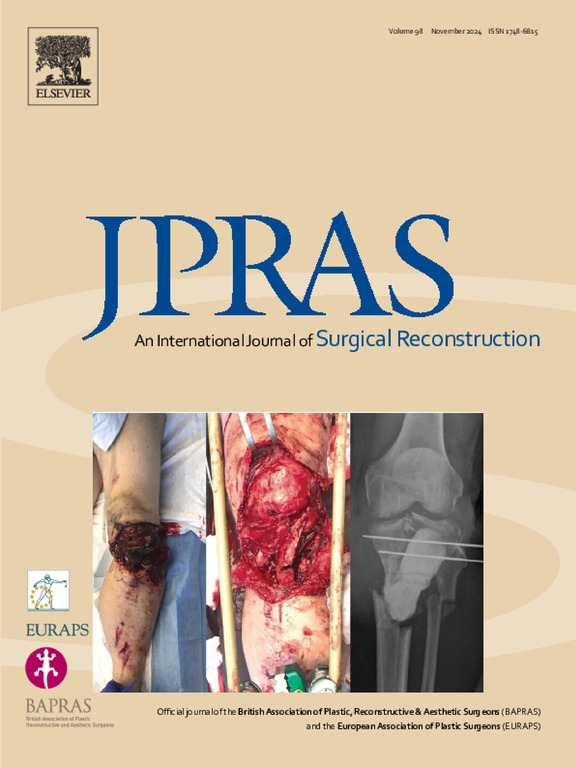术中短期电刺激能促进周围神经修复后的神经再生吗?系统回顾和荟萃分析。
IF 2.4
3区 医学
Q2 SURGERY
Journal of Plastic Reconstructive and Aesthetic Surgery
Pub Date : 2025-06-01
DOI:10.1016/j.bjps.2025.03.048
引用次数: 0
摘要
背景:虽然术中神经电刺激似乎是周围神经修复的一种有前途的神经增强辅助手段,但了解其对神经再生的影响对于提倡其在临床应用至关重要。目的:探讨电刺激在显微外科修复周围神经损伤过程中是否比单纯缝合修复更能促进实验动物神经再生。方法:系统检索Embase、MEDLINE、Web of Science、谷歌Scholar等数据库,检索时间自成立至2024年3月22日。这项研究包括动物研究,评估手术中有无电刺激的周围神经修复的结果。结果分为4类:运动功能、感觉功能、电生理和组织学。我们计算了标准化的平均差异,并使用随机效应模型将这些差异结合起来估计总体效果。使用cycle工具评估偏倚风险。结果:共纳入文献3615篇,21篇。13项研究评估了运动功能结果,并表明电刺激改善了功能指数、肌肉质量、肌肉力量、脚步准确性、足迹和关节角度测量。六项研究检查了感觉功能,发现电刺激改善了机械疼痛测量。9项研究评估了电生理结果。虽然传导速度在两组之间没有差异,但电刺激导致了更高的振幅和更低的潜伏期。20项研究评估了组织学结果,显示轴突计数和髓鞘厚度增加,而轴突直径和g比没有差异。讨论:结果表明,与单纯神经修复相比,术中电刺激周围神经修复后可加速和改善神经再生。系统评价注册:PROSPERO CRD42023455066。本文章由计算机程序翻译,如有差异,请以英文原文为准。
Does short-term intraoperative electrical stimulation enhance nerve regeneration following peripheral nerve repair? A systematic review and meta-analysis
Background
Although intraoperative electrical nerve stimulation appears to be a promising neuroenhancing adjunct to peripheral nerve repair, insight into its effects on nerve regeneration is essential to advocate its application in clinical settings.
Objective
This study examined whether electrical stimulation during microsurgical repair of peripheral nerve injury results in enhanced nerve regeneration compared to suture repair alone in experimental animals.
Methods
A systematic search in Embase, MEDLINE, Web of Science, and Google Scholar databases was performed from inception to March 22, 2024. The search included animal studies assessing outcomes following peripheral nerve repair with and without intraoperative electrical stimulation. Outcomes were subdivided into 4 categories: motor function, sensory function, electrophysiology, and histology. We calculated standardized mean differences and combined these using random effects models to estimate the overall effect. The risk of bias was assessed using the SYRCLE tool.
Results
From 3615 references, 21 articles were included. Thirteen studies evaluated motor functional outcomes and showed that electrical stimulation improved functional index, muscle mass, muscle force, footstep accuracy, footprint, and joint angle measures. Six studies examined sensory function and found that electrical stimulation improved mechanical algesimetry. Nine studies assessed electrophysiology outcomes. Although conduction velocity did not differ between the groups, electrical stimulation resulted in a higher amplitude and lower latency. Twenty studies evaluated the histological outcomes and demonstrated increased axon count and myelin thickness, whereas axon diameter and G-ratio did not differ.
Discussion
The results suggest that intraoperative electrical stimulation following peripheral nerve repair accelerates and improves nerve regeneration compared with nerve repair alone.
Systematic review registration
PROSPERO CRD42023455066.
求助全文
通过发布文献求助,成功后即可免费获取论文全文。
去求助
来源期刊
CiteScore
3.10
自引率
11.10%
发文量
578
审稿时长
3.5 months
期刊介绍:
JPRAS An International Journal of Surgical Reconstruction is one of the world''s leading international journals, covering all the reconstructive and aesthetic aspects of plastic surgery.
The journal presents the latest surgical procedures with audit and outcome studies of new and established techniques in plastic surgery including: cleft lip and palate and other heads and neck surgery, hand surgery, lower limb trauma, burns, skin cancer, breast surgery and aesthetic surgery.

 求助内容:
求助内容: 应助结果提醒方式:
应助结果提醒方式:


